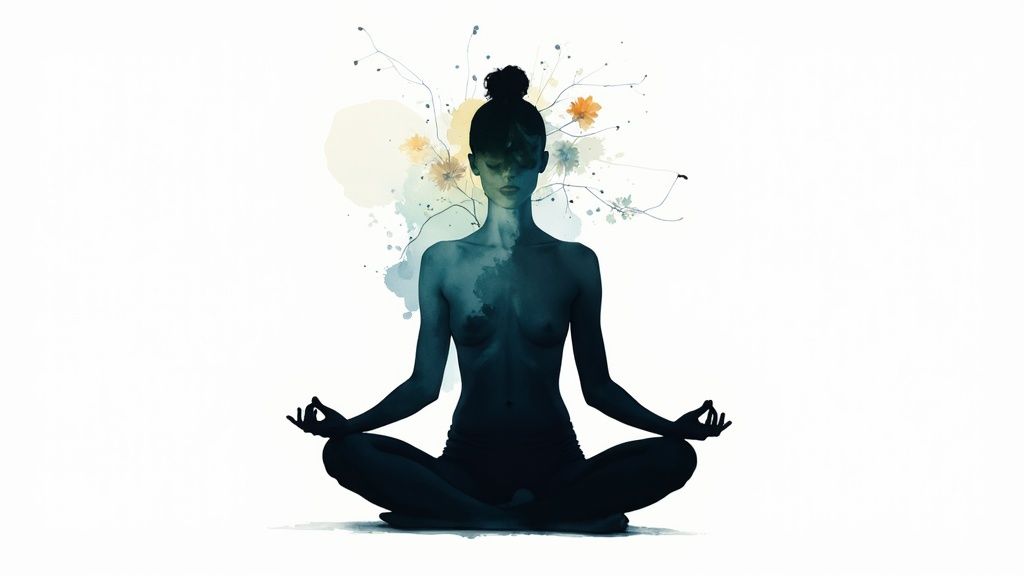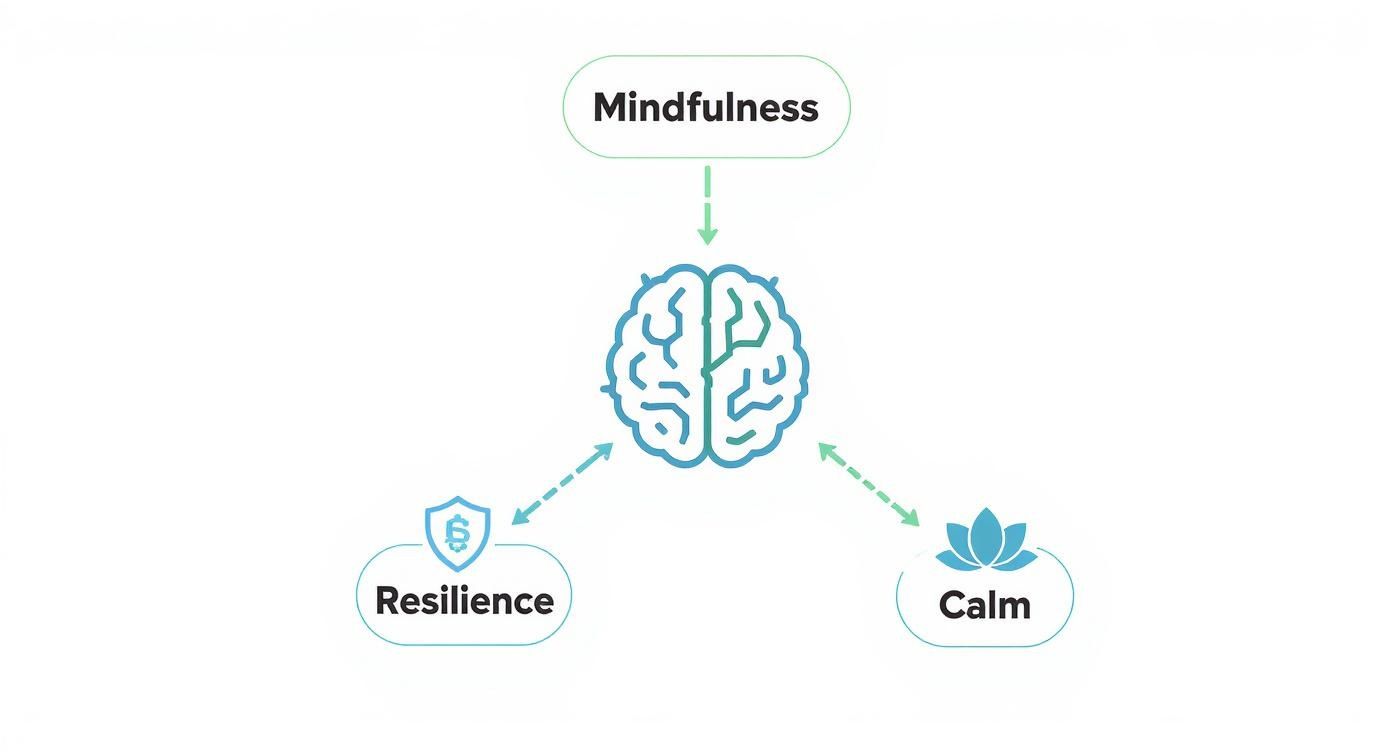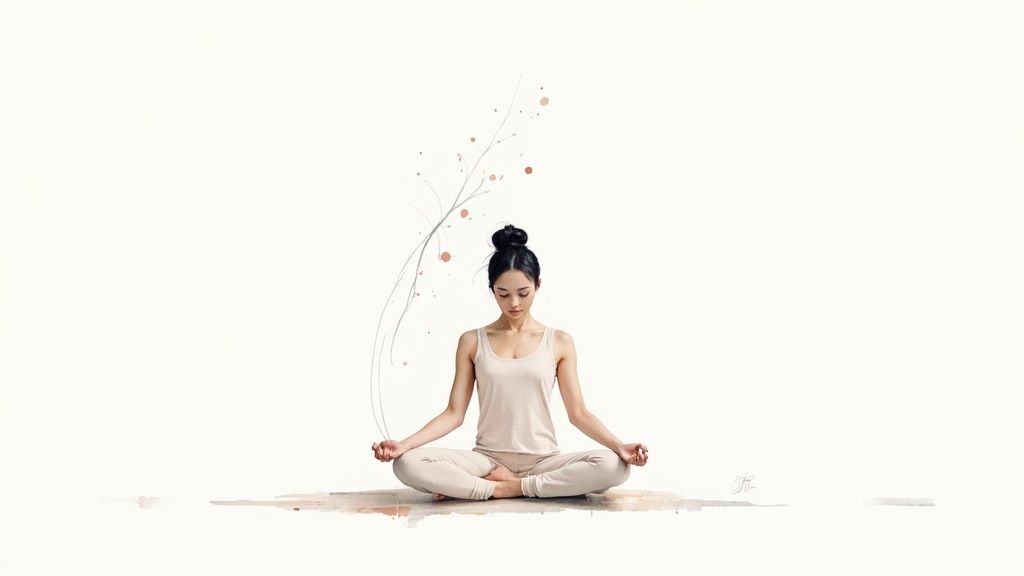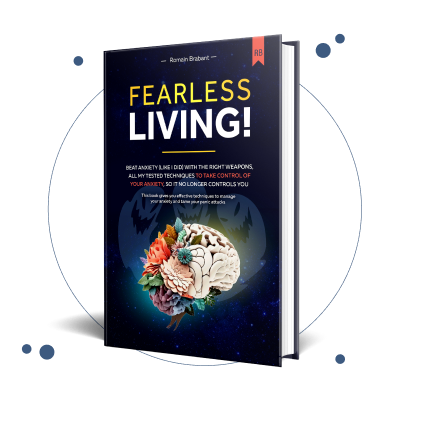
If you feel trapped by the relentless cycle of anxiety or overwhelmed by sudden panic, know this: there is a clear path forward to healing. The benefits of mindfulness go way beyond simple relaxation; it's a practical, science-backed method for reclaiming control over your mind and building a life free from the grip of panic.
Finding Calm in a World of Chaos
Living with anxiety can feel like being caught in a storm with no shelter. Your mind races, your heart pounds, and the future seems like a constant source of dread. It’s exhausting, deeply isolating, and can make you feel like this is your life forever. But it doesn't have to be.
What if you could learn to find the eye of that storm? What if you had a tool, not to stop the storm from happening, but to stand firmly and calmly right in the middle of it, knowing you are safe?
That's the promise of mindfulness. It isn't some complex spiritual practice or a passing trend. It’s the simple, powerful act of paying attention to the present moment—on purpose and without judging yourself for it. It's about noticing your breath, feeling the ground under your feet, and observing your thoughts without getting swept away by them. This is the first step toward a life where you are in control, not your anxiety.
Mindfulness is the practice of purposely focusing your attention on the present moment—and accepting it without judgment. This allows you to step out of the cycle of worry about the future or regrets about the past, creating a space for peace and healing.
A New Relationship with Your Thoughts
For many of us struggling with anxiety, the biggest battle is with our own thoughts. Anxious thoughts can feel like bullies, dictating your emotions and pushing you into a state of panic. Mindfulness offers a completely different, more hopeful approach.
Instead of fighting those thoughts, you learn to see them for what they are: just thoughts. Not undeniable truths. Not commands you have to obey.
This practice helps create a small but powerful space between a trigger and your reaction. In that space, you find freedom and hope. You start to realize that you are not your anxiety; you are the one observing it. This shift is the first real step toward breaking free from panic and healing completely.
It offers genuine hope by empowering you with practical skills to:
- Reduce the intensity of anxious feelings, proving they can't hurt you.
- Interrupt the spiral of panic before it takes over, giving you back control.
- Cultivate a deep sense of inner calm that you can access anytime, anywhere, building a foundation for a panic-free life.
This guide will show you exactly how this is possible for you.
How Mindfulness Rewires Your Brain for Peace
If you're living with anxiety, it can feel like your brain is actively working against you, caught in a relentless cycle of worry and alarm. But here’s the hopeful truth: one of the most powerful aspects of mindfulness is its ability to physically change your brain's structure and function.
This isn't just wishful thinking; it's a scientific reality known as neuroplasticity, and it’s the key to building lasting peace and healing from the inside out.
Imagine your anxious thoughts are a well-worn path through a grassy field. The more you walk down it, the deeper and wider that path becomes, making it almost second nature to fall into the same pattern of worry. Mindfulness is like intentionally choosing to walk a new path—one of calm, present-moment awareness, and safety.
At first, this new path feels a bit strange. But with consistent practice, you start carving out a fresh neural pathway. Over time, this new "calm" path gets stronger and more defined, and eventually, it becomes the brain's new default. This is how you heal. This is how you become panic-free.
Training Your Attention and Focus
One of the first things mindfulness strengthens is your ability to control where you place your focus, a skill called attention regulation. When anxiety hits, your attention gets hijacked by "what-if" scenarios and perceived threats, pulling you down a rabbit hole of panic.
Mindfulness exercises—even something as simple as focusing on your breath—are like a workout for your prefrontal cortex, the part of your brain in charge of focus and decision-making. Each time your mind wanders off and you gently guide it back, you’re doing another "rep" and strengthening that mental muscle.
This improved focus lets you notice an anxious thought without immediately getting swept away by it. It gives you the power to choose where you direct your attention, instead of letting fear make the choice for you. This is a foundational skill for a life without panic.
The infographic below shows how this practice builds up your resilience, sense of control, and overall calm.

As this map illustrates, training your brain with mindfulness directly leads to better emotional control and a more resilient, calmer state of being.
Learning to Respond, Not React
Anxiety often sounds the body's internal alarm, triggering impulsive, fear-based reactions. This is a core part of the fight-or-flight response, where your amygdala (the brain's fear center) takes the driver's seat.
Mindfulness helps you develop better emotional regulation by creating a crucial pause between a trigger and your reaction.
By observing your emotions without judgment, you learn that feelings are temporary signals, not urgent commands. This space allows you to respond thoughtfully instead of reacting automatically from a place of fear.
This skill is a game-changer for becoming panic-free. For example, when you feel your heart start to race, instead of immediately thinking, "Oh no, I'm having a panic attack!" you can learn to simply observe, "My heart is beating quickly."
This subtle shift in perspective changes your relationship with the physical symptoms of anxiety, draining them of their power. If you want to understand this automatic reaction better, our in-depth fight-or-flight response guide explains how mindfulness can help get it under control.
By practicing this kind of mindful observation, you're effectively turning down the volume on your amygdala and giving your prefrontal cortex—the rational part of your brain—a chance to come back online. This is how you start to heal, proving to yourself that you can navigate intense feelings without being controlled by them and paving the way for a panic-free life.
Proven Mental and Emotional Benefits

Talking about the benefits of mindfulness isn't just a feel-good exercise; it's about finding a real, tangible path toward healing from anxiety. The shifts you can experience aren't abstract concepts. They are genuine, day-to-day changes that give you back a sense of control and a deep, unshakable hope for the future.
This is where the science behind mindfulness becomes personal. With consistent practice, you start to gently untangle the tight knots of worry that have held you captive. The relief you feel is real, and it’s built to last.
A Significant Reduction in Anxiety and Stress
One of the first things people notice is mindfulness's profound effect on stress and anxiety. Regular practice helps dial down cortisol—the body's main stress hormone—which creates a much calmer baseline for your entire nervous system.
Think of your anxiety like a fire alarm that's stuck blaring. Mindfulness is what helps you find the switch to turn it off, giving your mind and body the profound relief of finally standing down from high alert.
This isn't just a feeling; it’s backed by compelling evidence. A massive global study showed that just 10 minutes of daily mindfulness led to a 12.6% greater drop in anxiety and a 19.2% greater reduction in depression symptoms compared to a group that didn't practice. This shows how small, steady efforts can create huge wins for your mental well-being and put you on the path to recovery.
Mindfulness teaches you to accept your feelings—including painful ones—without reacting with aversion. This acceptance drains anxiety of its power, proving that you can handle these emotions without being overwhelmed by them.
This skill is absolutely crucial for breaking free from the grip of panic. Instead of living in fear of anxious feelings, you learn to watch them come and go with a sense of calm detachment, knowing you have what it takes to navigate them and return to a peaceful state.
Cultivating Greater Emotional Resilience
Beyond just taming anxiety, mindfulness builds something even more valuable: emotional resilience. This is your ability to bounce back from tough times and manage difficult emotions without getting knocked completely off balance. It’s the difference between being a small boat tossed around by every wave and being a sturdy ship that can navigate even the roughest seas with confidence.
Mindfulness strengthens this inner capacity in a few key ways:
- It enhances emotional regulation: You learn to respond to your feelings with intention instead of reacting impulsively out of fear.
- It boosts self-compassion: The practice encourages you to be kinder to yourself, quieting that harsh inner critic that so often fuels anxiety and hopelessness.
- It improves focus and clarity: By training your attention, you get better at seeing situations for what they are, without the distorting lens of panic.
Keeping track of these shifts can be a powerful part of the healing process. When you pair mindfulness with other practices, like journaling, you can see your progress and deepen your self-awareness. If that sounds interesting, you can discover what journaling is and its many benefits in our detailed guide.
To get an even deeper understanding of how your mind and body can benefit, you can also explore the mindful meditation secrets to enhancing emotional and physical well-being. These practices offer a hopeful and achievable path toward a life that is no longer defined by anxiety.
Strengthening Your Physical Health and Resilience
Anxiety isn’t just a battle in your mind—it’s a full-body experience that can leave you physically exhausted and unwell. The relentless tension, the racing heart, the sleepless nights… they all take a massive toll and can make healing feel impossible.
This is where one of the most powerful benefits of mindfulness comes into play. It gets right to the heart of the mind-body connection, offering a real path to physical healing and renewed energy. By calming your nervous system, you can start to undo the physiological damage caused by chronic stress. It’s about creating an internal environment where genuine health can take root, giving you the strength to heal fully.
Lowering Stress Hormones and Calming Your Body
When you’re stuck in an anxiety loop, your body is often swimming in cortisol, the primary stress hormone. Persistently high cortisol levels are linked to everything from high blood pressure and a weakened immune system to crushing fatigue and poor sleep.
Mindfulness acts as a natural brake pedal.
Through simple, intentional practices, you send a signal to your body that the threat has passed. This helps dial down cortisol levels, allowing your systems to come back into balance. The physical relief that follows can be profound, giving you a tangible sense that you can feel better—not just in your head, but in your entire body.
By intentionally calming the mind, you directly calm the body. This process helps break the feedback loop where physical symptoms of stress trigger more anxious thoughts, and vice versa, creating an upward spiral of healing.
Building a Foundation for Holistic Wellness
Structured programs like Mindfulness-Based Stress Reduction (MBSR) have been scientifically shown to deliver lasting physical health benefits. Participants often see measurable improvements in their immune function, cardiovascular health, and blood pressure. These aren't small changes; they're physiological shifts that directly combat the exhaustion of anxiety. You can dive deeper into the science by reading the full research on how MBSR supports physical well-being.
The result? Better sleep, reduced chronic pain, and more energy to fully engage in your life again.
Tracking these improvements can be incredibly motivating. Getting a handle on key health markers, like those in a Comprehensive Metabolic Panel, can show you the concrete results of your mindfulness practice over time. This gives you solid proof that you are actively healing.
These physical benefits aren’t separate from your mental recovery; they’re essential to it. When your body is calmer and more resilient, you have a stronger foundation from which to manage anxious thoughts. A calmer body makes for a calmer mind, and together they create the conditions for a life free from panic.
Integrating these practices with supportive nutrition is another key piece of the puzzle. Our guide on lifestyle and diet changes for anxiety management offers practical, straightforward tips. Every step you take to support your physical health strengthens your ability to heal from anxiety completely.
Simple Practices to Begin Your Healing Journey

Jumping into mindfulness doesn't mean you have to carve out hours for silent meditation. Not at all. The path to a panic-free life really just starts with a few small, deliberate steps.
These simple exercises are designed to be practical and easy to fit into your day, especially when you feel those first whispers of anxiety.
The idea isn't to be perfect. It’s about gently nudging your mind back to an anchor in the present moment. Every time you practice, you’re sending a clear, powerful message to your nervous system: "I am safe. I am in control." This is the foundation of healing.
The 3-Minute Breathing Space
Think of this as a mental reset button you can press anywhere, anytime. It creates that crucial bit of daylight between an anxious thought and your reaction, giving you the power to choose a calmer response.
- Acknowledge: For the first minute, just notice what’s going on inside. What thoughts are swirling around? What feelings are you holding in your body? Simply acknowledge them without any judgment.
- Gather: In the second minute, gently bring your full attention to the physical sensation of your breath. Feel the gentle rise and fall of your abdomen. This is your anchor to safety in the present moment.
- Expand: For the final minute, let your awareness broaden to include your entire body. Feel the support of the ground beneath you and the space you're in, carrying this renewed sense of presence with you as you move forward.
The 5-4-3-2-1 Grounding Technique
When panic makes you feel like you're floating away from reality, this exercise is a lifesaver. It yanks your focus back to your immediate surroundings, calming your mind by putting your senses to work. It’s an incredibly potent way to slam the brakes on an anxiety spiral and prove you are safe.
Just look around and name:
- 5 things you can see: Get specific. Notice five distinct objects in the room.
- 4 things you can feel: Bring your attention to the texture of your jeans or the cool surface of a table.
- 3 things you can hear: Listen for three separate sounds, whether they’re close by or far away.
- 2 things you can smell: Identify two distinct scents in the air around you.
- 1 thing you can taste: Simply focus on the taste currently in your mouth.
These practices are so effective because they break the cycle of rumination. Instead of being held captive by worries about the future or regrets about the past, you become fully grounded in the here and now—which is always a place of safety and calm.
Remember, consistency trumps duration every single time. Research shows that even 10 to 21 minutes of practice three times per week can make a real difference, significantly lowering blood pressure and cutting down on repetitive negative thinking. You can read more about these findings on the NCCIH website.
These small investments in your well-being build a powerful foundation for lasting change. For more guidance, dive into our in-depth article on using meditation for anxiety relief.
Creating Your Complete Anxiety Recovery Toolkit
Mindfulness shouldn’t feel like just another thing to add to your to-do list. Think of it as the foundation you build your entire recovery on—the glue that holds your strategy together and makes every other tool you use that much more effective.
It’s like developing an internal compass. When you practice mindfulness, you build a profound self-awareness that helps you spot your anxiety triggers sooner and with way more clarity. Instead of getting ambushed by panic, you start to see the warning signs from a distance and can choose how to respond calmly and effectively.
This is what puts you back in the driver's seat of your life. With a few mindful techniques in your back pocket, you have a reliable way to ground yourself when your heart starts to pound or your thoughts begin to spiral. This isn't about fighting anxiety; it's about learning to navigate it so skillfully that it loses its power over you, allowing you to heal completely.
Integrating Mindfulness for Lasting Healing
True, lasting recovery isn’t about finding one magic bullet. It’s about combining powerful tools into a plan that works for you. Mindfulness gives you the core skills that make structured programs and therapies even more impactful.
It strengthens you in two critical ways:
- Emotional Regulation: You learn how to sit with difficult feelings without letting them swallow you whole. This is a game-changer for stopping panic attacks and building a life where they no longer happen.
- Self-Compassion: Mindfulness teaches you to be kind to yourself, which is absolutely essential for sticking with your recovery, especially on the days that feel hard.
By integrating mindfulness, you're not just coping; you're actively creating a new relationship with your mind. You are building a powerful, personalized toolkit that proves healing is not only possible but achievable.
This proactive approach gives you a sense of control again. And as you get more confident in managing your inner world, you can start layering in other supportive practices. Our guide to breathing exercises for anxiety, for example, offers techniques that pair perfectly with mindfulness, helping you build a comprehensive strategy for lasting calm.
Common Questions About Mindfulness for Anxiety
Jumping into a new practice can feel a little uncertain, especially when you’re looking for a real solution to anxiety. It’s completely normal to have questions and even a bit of skepticism. So, let’s clear up a few common concerns to give you the confidence that this path can lead to real healing.
How Long Until I See the Benefits?
This is the big one, isn't it? The answer is both encouraging and realistic: you can feel small shifts almost immediately. The very first time you practice, you're interrupting a spiral of anxious thoughts, even if it’s just for a moment. That interruption is a win and a sign of hope.
But the deeper, more lasting changes—like a calmer nervous system and living free from panic—come from consistency. Research shows that noticeable changes in the brain can happen within just a few weeks of regular practice. It’s not an overnight fix, but a steady, empowering journey toward a life with less panic and more peace.
Do I Have to Completely Clear My Mind?
Absolutely not. This is probably the biggest myth about mindfulness and the number one reason people think they’re "failing" at it. The goal is not to have a perfectly empty mind. Honestly, that’s impossible.
The real goal is to simply notice when your mind has wandered, and then gently, without judgment, guide your attention back to your anchor, like your breath. Every time you do this, you are successfully practicing mindfulness.
It's all about observing your thoughts, not fighting them. That gentle act of returning your focus, over and over, is where the real power to heal lies.
Is It Normal for Anxiety to Feel Worse at First?
Sometimes, yes, and it's a hopeful sign. Think about it: when you finally quiet down and start paying attention to what's happening inside, you might notice just how loud your anxiety really is. It can feel unsettling at first, but it's actually a sign you're making progress.
You’re building awareness. Instead of running from your feelings or distracting yourself, you're learning to sit with them. This initial discomfort doesn't last. As you continue to practice, it gives way to a deeper sense of control and resilience. It's a crucial first step in learning to manage anxiety instead of letting it manage you on your path to a panic-free life.
If you're ready to build a complete toolkit for lasting recovery, The Anxiety Checklist provides a structured, actionable system to guide you. It combines practical strategies like these with a comprehensive plan to help you move from feeling overwhelmed to living a fearless life.
Learn how to build your personalized recovery plan at https://anxietychecklist.com.

